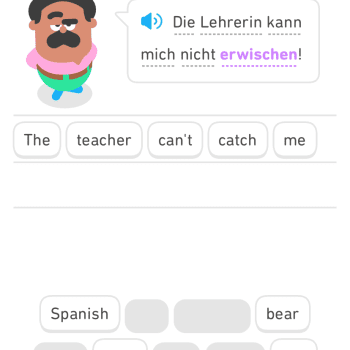As most readers are aware, this summer I taught my course on the Bible online for the first time. Now that it is complete, I want to offer some reflections on the experience, beginning from what I brought to the course, the preparations, and the actual delivery and implementation.
Prior experience:
I had some prior experience with “online teaching,” but it really was much more along the model of distance learning. It essentially involved students studying on their own according to a course packet that they were given at the start of the course, which happened to be online on Blackboard, but which otherwise was much like the sort of packet one might have received through the mail back in the era of “correspondence courses.” My role was simply to grade students’ assignments. And so teaching an online course in the sense that that phrase now has, with the full extent of current options and opportunities for full-fledged interactivity across a wide array of digital media, was still something new to me.
Preparations:
 I was fortunate inasmuch as the idea of “flipping the classroom” has caught my attention several years ago. And so I had begun recording my classes using Panopto, which captures audio plus whatever is on the screen, in my case usually Powerpoint. When I began to develop the online course, I used those recordings, editing them as necessary, and also recorded some reduced lectures in my office, omitting the parts when, in the classroom, I would normally have paused to allow for discussion. I used both “live” and “studio” recordings for the class. Having used some Michel Thomas Method language courses, I knew that it could be pedagogically useful for students to have recordings which included not only the professor speaking, but also students. Many blog readers will have heard some of those recordings which I posted to YouTube and shared here on this blog.
I was fortunate inasmuch as the idea of “flipping the classroom” has caught my attention several years ago. And so I had begun recording my classes using Panopto, which captures audio plus whatever is on the screen, in my case usually Powerpoint. When I began to develop the online course, I used those recordings, editing them as necessary, and also recorded some reduced lectures in my office, omitting the parts when, in the classroom, I would normally have paused to allow for discussion. I used both “live” and “studio” recordings for the class. Having used some Michel Thomas Method language courses, I knew that it could be pedagogically useful for students to have recordings which included not only the professor speaking, but also students. Many blog readers will have heard some of those recordings which I posted to YouTube and shared here on this blog.
Butler’s Center for Academic Technology provided a development or “sandbox” course where I could try things out and develop the course over the year prior to its being offered in our new Course Management System, Moodle. I found that Moodle actually allowed me to offer something that I had long wanted to implement, namely interactive course materials. I thus set up the introduction to the course as a module which asked students questions and presented introductory material that was customized based on their answers.
I put in place a syllabus, details about assignments, discussion boards with prompts, readings, and additional text to try to cover things which I might simply say in class at some point. I was somewhat anxious about whether I had actually explained, introduced, and otherwise said all that needed to be said, prior to the class starting. The final exam involved a question pool from which a random subset would be offered to each student, from which they had to choose one to answer. This allowed the exam, like the rest of the course, to be asynchronous. In fact, I allowed several days over which students could take the final. While certain components of the course, such as discussions, were scheduled for specific days, students did not have to do them at specific times.
Implementation:
 It was rather nerve-wracking to make the course available. The thing that I was most nervous about, other than general technical issues, was discussion, which is normally a major component of the in-classroom version of the course. Would discussion boards be able to provide the same communal learning experience? Would students really engage and discuss in this manner?
It was rather nerve-wracking to make the course available. The thing that I was most nervous about, other than general technical issues, was discussion, which is normally a major component of the in-classroom version of the course. Would discussion boards be able to provide the same communal learning experience? Would students really engage and discuss in this manner?
That part actually went much better than I could have hoped. There were, as is typical in the more traditional form of the course, a small number of students who were eager to discuss and tended to get things started. Most students joined in, and even though I expected discussions to take place on specific days, students could get partial participation credit by posting late, and also boost their participation grade by continuing the conversation even after the scheduled day.
Now that the course is over, it is particularly the use of discussion boards that has me wondering how I should allow this experience of teaching online to change, transform, and influence what I do during the semester. In-class participation and discussion is so hard to quantify and grade. Through the use of discussion boards, students were writing more than they might have in the in-classroom version. And it was so much easier for me to quantitatively and qualitatively assess participation. In small group discussions in a classroom, a professor cannot hear everything that is said, or really tell who is participating fully, beyond a few clear cases and a larger number of vague impressions.
I might integrate discussion boards during the semester. And moving lecture to outside the class also seems to make more sense. And so the question becomes what I will do in class. Fun activities that work better face to face or can only be done in that setting? Work on assignments and graded projects, along the “flipped classroom” model?
I found the offering of my class online rewarding, and the number of students who enrolled (we had to open a second section!) encouraging as an expression of enthusiasm. I found the fact that a few students chose neither to withdraw nor to participate saddening. And I am wondering how to best use technology that I utilized for the online course not only the next time I offer a course in that way, but also during the regular semester.
have you taught a course online? Taken one? Signed up for but never completed a MOOC? Had online teaching methods and technologies impact your more traditional in-classroom course? Please share your experiences!












